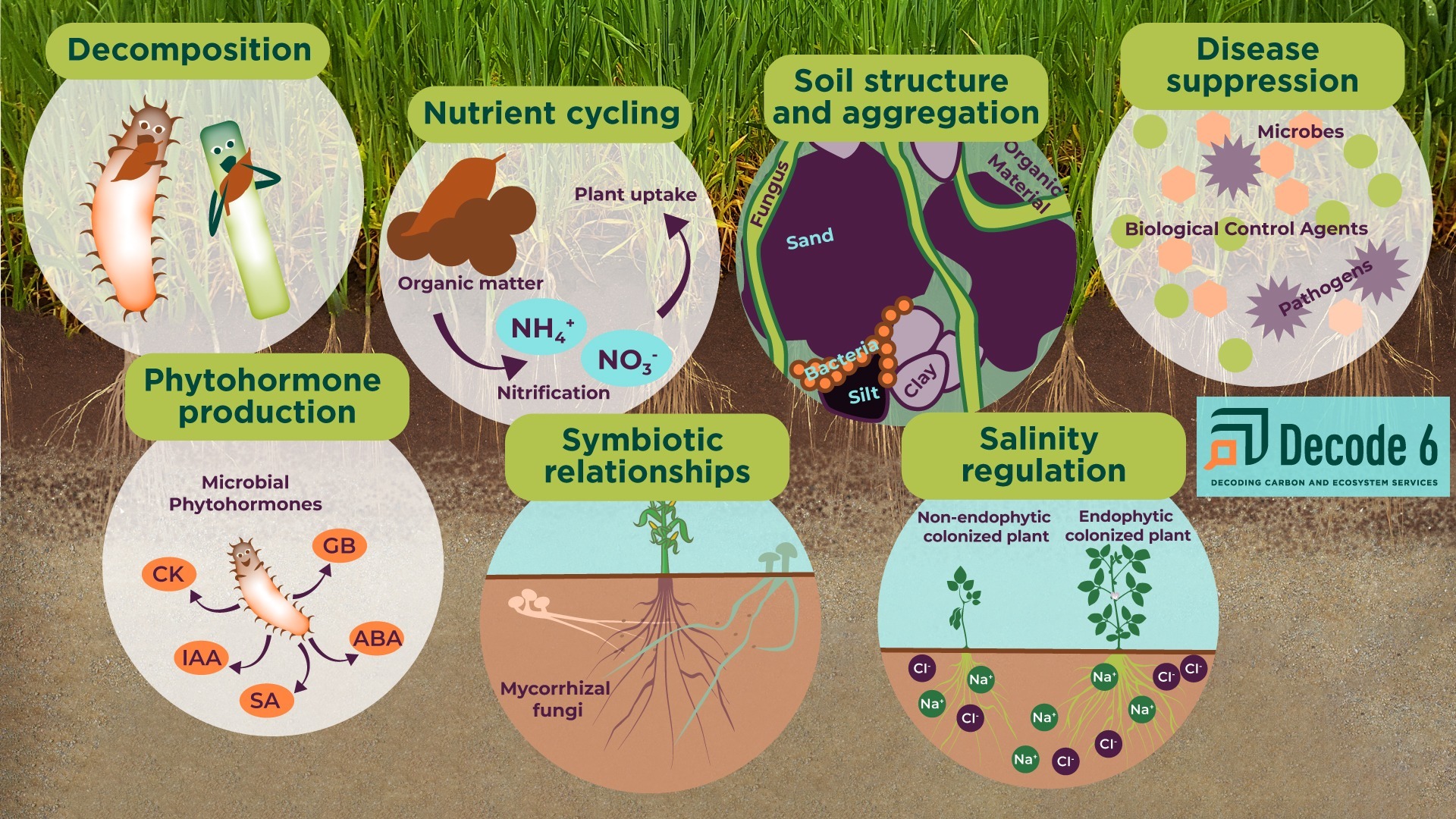What Do Microbes Do in the Soil?
The short answer: Soil microbes play an important role in maintaining soil health and crop performance. Plus, microbes are one of the largest drivers of soil carbon storage.
- They perform various activities that include decomposition, nutrient cycling, soil particle aggregation, nitrogen fixation, disease suppression, phytohormone production, and salinity regulation.
- Many microbes also form mutually beneficial symbiotic relationships with crops, establishing synergies that promote efficient resource utilization and support agronomic outcomes in terms of yield.

Soil microbes contribute to decomposition, nutrient cycling, soil structure and aggregation, disease suppression, phytohormone production, symbiotic relationships, and salinity regulation. Graphic by Karen Brey.
Break it down: We can break the specific functions of soil microbes into seven big groups. Let’s dig in.
- Decomposition: Microbes–bacteria and fungi–break down organic matter like crop residues, insect carcasses, animal manure, and other organic materials in the soil.
- Microbes secrete enzymes that help to break down complex organic compounds into simpler forms, releasing nutrients that plants can use.
- Microbes contribute to humification as they decompose organic compounds. Humification produces stable, mature organic compounds that increase soil organic matter content. This offers additional benefits to crops, such as elevated water-holding capacity, nutrient retention, and carbon sequestration.
- Nutrient cycling: Microbes are involved in the cycling of essential nutrients in the soil. They can “unlock” nutrients that are stuck in forms unavailable to the plant and therefore promote the availability of nutrients for plant uptake.
- Nitrogen release (mineralization) is one example of how many beneficial soil microbes convert organic nutrients into inorganic forms that can be taken up by plants.
- Soil microbes also unlock nutrients from inorganic “bound-up” forms.
- Soil structure and aggregation: Certain bacteria and fungi produce sticky substances like polysaccharides that bind soil particles together, forming aggregates.
- Soil aggregates improve soil structure, porosity, and water-holding capacity, allowing better root penetration and aeration.
- Disease suppression: Certain beneficial bacteria and fungi called biocontrol agents can suppress soil-borne pathogens and pests.
- Biocontrol agents suppress pathogens and pests through various processes, including: producing antimicrobial compounds, consuming or parasitizing pests and pathogens, or outcompeting pathogens for niches in the soil.
- The term “disease suppressive soils” is often used to refer to fields that experience little to no impacts from soilborne diseases, even when diseases are prevalent throughout the surrounding region or minimal crop protection products are used. Microbial biocontrol agents are known to play a key role in the ability of disease-suppressive soils to mitigate pathogen impacts.
- Phytohormone Production: Some soil microbes can produce plant hormones in the soil, many of which are commonly referred to as “plant growth regulators” or PGRs.
- Hormones such as auxin, cytokinin, and gibberellin are known to support plant growth, yield, and stress tolerance when applied as foliar products. Still, they can be very expensive to apply routinely.
- Microbial hormone producers in the soil can offer these benefits as well and have been found to support crop resistance to stressors like drought and activate plant defense systems to thwart pathogens.
- Symbiotic Relationships: Many plants form beneficial symbiotic relationships with soil microbes.
- Mycorrhizal fungi form associations with plant roots, extending their reach for water and nutrients in exchange for microbial “food” in the form of carbon produced by the plant via photosynthesis.
- Mutually beneficial bacteria, known as endophytes, live in plant tissues and promote plant growth by performing beneficial processes such as nitrogen fixation and receiving carbon through root exudates. This symbiotic relationship enhances plant nutrient uptake, overall plant and soil health, and the efficiency of agricultural systems. However, common agricultural practices can disrupt these relationships, leading to a decline in beneficial microbes and increased dependence on agricultural inputs.
- Salinity Regulation: Some microbes have adapted to survive in saline environments and possess mechanisms to tolerate high salt concentrations. They can actively colonize and thrive in saline soils where other organisms struggle.
- Salt exclusion is where certain microbes have mechanisms to exclude salts from their cells or limit their uptake actively. By excluding salts, microbes can ensure proper cellular functioning and growth in high-salinity conditions.
- Salt metabolism is where particular microbes possess enzymes that can metabolize or break down specific types of salts. They can convert salts into less harmful forms or compounds that other organisms can utilize.
In short, balancing disturbances to the microbiome with practices that support plant-microbe symbioses, such as cover crops and conservation tillage, is crucial for optimizing soil health processes and leveraging the benefits of soil microbes.
Graphic by Biome Makers.








